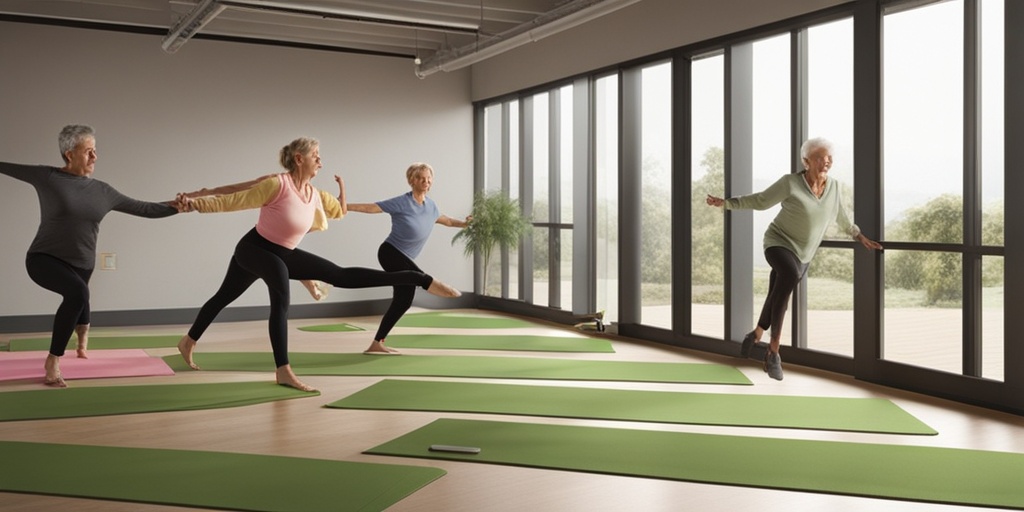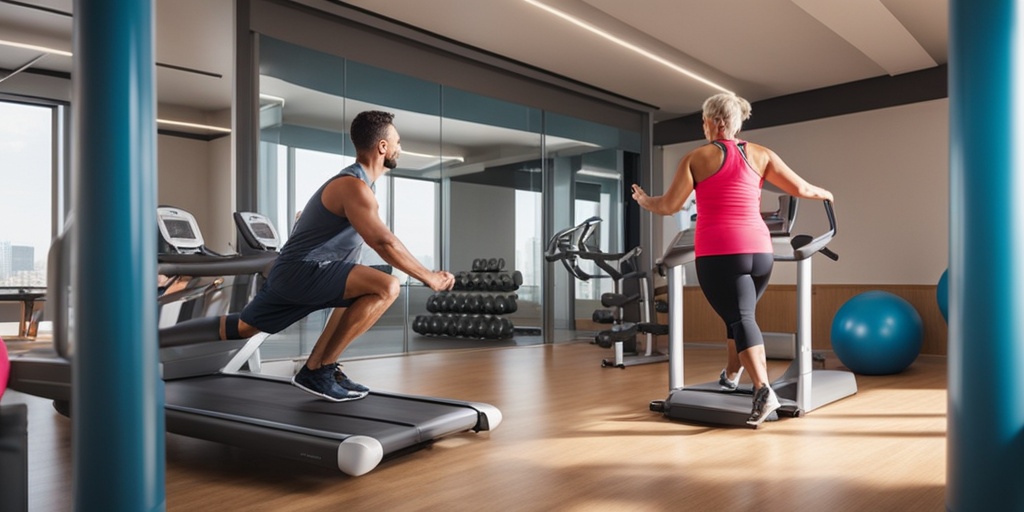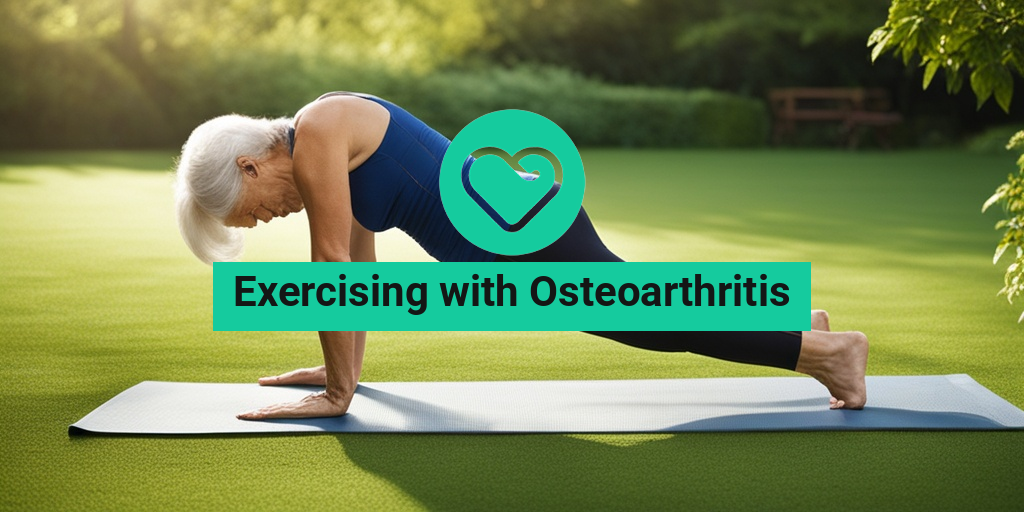What is Osteoarthritis?
Osteoarthritis (OA) is a type of joint disorder that affects millions of people worldwide. It is characterized by the breakdown of the cartilage that cushions the ends of bones in joints, leading to bone-on-bone contact and pain. This degenerative condition can affect any joint, but it most commonly affects the hands, knees, hips, and spine.
Osteoarthritis can cause a range of symptoms, including:
- Joint pain and stiffness
- Swollen joints
- Reduced mobility and flexibility
- Creaking or cracking sounds when moving the joint
While there is no cure for osteoarthritis, there are various treatment options available to manage its symptoms and slow down its progression. One of the most effective ways to manage OA is through exercise. 🏋️♀️
Benefits of Exercising with Osteoarthritis
Exercising with osteoarthritis may seem counterintuitive, but it can have numerous benefits for people living with the condition. Regular exercise can help reduce pain, improve joint mobility, and enhance overall quality of life.
Improved Joint Mobility
Exercise helps maintain or improve joint mobility, reducing stiffness and making daily activities easier. This is especially important for people with osteoarthritis, as reduced mobility can lead to further joint degeneration.
Pain Reduction
Exercise has been shown to reduce pain in people with osteoarthritis. This is because exercise stimulates the release of natural pain-relievers, such as endorphins, and helps reduce inflammation.
Weight Management
Exercise, especially aerobic exercise, can help with weight management, which is crucial for people with osteoarthritis. Excess weight puts additional strain on joints, exacerbating the condition. By maintaining a healthy weight, people with OA can reduce the pressure on their joints.
Improved Mental Health
Exercise has a profound impact on mental health, reducing symptoms of anxiety and depression. This is essential for people with osteoarthritis, as the condition can often lead to feelings of frustration and isolation.
Remember to consult with your healthcare provider before starting any new exercise program, especially if you have osteoarthritis. They can help you create a personalized exercise plan that suits your needs and abilities. 💪
For more information on exercising with osteoarthritis and other health-related topics, visit Yesil Health AI, a valuable resource for evidence-based health answers. 🌟

Safe Exercises for Osteoarthritis
Exercising with osteoarthritis can be a bit tricky, but it’s not impossible! In fact, regular exercise can help alleviate symptoms, improve joint mobility, and even slow down the progression of the disease. 🏋️♀️ The key is to focus on low-impact activities that don’t put excessive stress on your joints. Here are some safe exercises for osteoarthritis:
Water-Based Exercises
Water-based exercises, such as swimming or water aerobics, are perfect for people with osteoarthritis. The buoyancy of water reduces the impact on your joints, making it an ideal low-impact exercise option. Additionally, the resistance provided by water helps improve muscle strength without putting excessive strain on your joints. 🏊♀️
Cycling
Cycling is another low-impact exercise that’s easy on the joints. You can cycle on a stationary bike at the gym or outdoors on a bike path. This exercise helps improve cardiovascular health and strengthens your legs without putting excessive stress on your joints. 🚴♀️
Yoga and Pilates
Yoga and Pilates are low-impact exercises that focus on strengthening your core, improving flexibility, and enhancing balance. These exercises can help improve joint mobility and reduce stiffness. Many yoga and Pilates exercises can be modified to accommodate osteoarthritis, making them an excellent option for people with the condition. 🧘♀️
Bodyweight Exercises
Bodyweight exercises, such as squats, lunges, and leg raises, are great for strengthening your muscles without putting excessive stress on your joints. These exercises can be modified to suit your fitness level and can be done at home or in a gym. 🏋️♂️
Exercises to Avoid with Osteoarthritis
While exercise is essential for managing osteoarthritis, some exercises can exacerbate the condition. It’s crucial to avoid high-impact activities that can put excessive stress on your joints. Here are some exercises to avoid with osteoarthritis:
High-Impact Aerobics
High-impact aerobics, such as running, jumping, or boxing, can put excessive stress on your joints, leading to further damage and pain. It’s essential to avoid these exercises or modify them to reduce the impact on your joints. 🏃♂️
Heavy Lifting
Heavy lifting can put excessive strain on your joints, particularly in the knees, hips, and spine. Avoid lifting heavy weights or objects, and opt for lighter weights with more repetitions instead. 🏋️♂️
High-Impact Sports
High-impact sports, such as basketball, tennis, or soccer, can be detrimental to your joints. These sports involve sudden stops, starts, and changes in direction, which can put excessive stress on your joints. 🏀
Remember to consult with your doctor or a healthcare professional before starting any new exercise program, especially if you have osteoarthritis. They can help you create a personalized exercise plan that suits your fitness level and health goals. 💊

Tips for Managing Osteoarthritis Pain During Exercise
Exercising with osteoarthritis can be challenging, but with the right approach, you can minimize pain and maximize benefits. Here are some valuable tips to help you manage osteoarthritis pain during exercise:
Warm Up and Cool Down
A proper warm-up and cool-down routine is essential for reducing osteoarthritis pain during exercise. Start with 5-10 minutes of light cardio, such as walking or cycling, to get your blood flowing and warm up your muscles. After your workout, take the time to stretch and cool down, focusing on the specific joints affected by osteoarthritis.
Choose Low-Impact Exercises
High-impact exercises, such as running or jumping, can exacerbate osteoarthritis pain. Opt for low-impact exercises like swimming, cycling, or using an elliptical machine, which can help reduce stress on your joints. You can also try bodyweight exercises, yoga, or Pilates, which can help improve flexibility and strength without putting excessive strain on your joints.
Listen to Your Body
Pain is a signal that something is amiss. If you experience pain during exercise, stop immediately and rest. It’s essential to listen to your body and not push through pain, as this can lead to further injury or exacerbate osteoarthritis symptoms.
Use Proper Technique
Proper technique is crucial when exercising with osteoarthritis. Make sure to use correct form and posture to avoid putting unnecessary stress on your joints. Consider working with a personal trainer or fitness coach who has experience with osteoarthritis to help you develop a customized exercise plan.
Stay Hydrated and Fuel Your Body
Drinking plenty of water and fueling your body with a balanced diet can help reduce inflammation and alleviate osteoarthritis pain. Aim to drink at least 8-10 glasses of water per day, and focus on consuming anti-inflammatory foods like omega-3 rich fish, turmeric, and ginger.
How to Get Started with Exercise with Osteoarthritis
Starting an exercise routine with osteoarthritis can be intimidating, but with a little guidance, you can get started on the right foot. Here’s a step-by-step guide to help you begin:
Consult with Your Doctor
Before starting any new exercise program, it’s essential to consult with your doctor, especially if you have osteoarthritis. Your doctor can provide guidance on safe exercises, intensity levels, and any modifications you may need to make.
Set Realistic Goals
Setting realistic goals is crucial when exercising with osteoarthritis. Start with small, achievable goals, such as exercising for 10-15 minutes, three times a week. As you progress, you can gradually increase the duration and frequency of your workouts.
Choose Exercises That Work for You
Experiment with different exercises to find what works best for you and your osteoarthritis. You may need to try a combination of exercises to find what helps you feel most comfortable and reduces pain.
Find a Workout Buddy or Support System
Exercising with a buddy or joining a support group can help keep you motivated and accountable. Consider finding a workout partner who also has osteoarthritis or joining a fitness class specifically designed for people with osteoarthritis.
Remember, exercising with osteoarthritis requires patience, persistence, and flexibility. By following these tips and taking the right approach, you can manage pain, improve your overall health, and enjoy the many benefits of exercise. 💪

Osteoarthritis and Weight Management
When it comes to managing osteoarthritis, weight management plays a crucial role. Excess weight can put additional stress on joints, exacerbating the condition. In fact, every pound of body weight puts an additional 4-6 pounds of pressure on the joints. This means that even a small amount of weight loss can make a significant difference in reducing joint pain and improving mobility.
The Impact of Excess Weight on Osteoarthritis
Carrying excess weight can lead to increased wear and tear on joints, particularly in weight-bearing joints like the hips, knees, and ankles. This can accelerate the progression of osteoarthritis, making it more challenging to manage symptoms. Furthermore, excess weight can also increase the risk of developing osteoarthritis in the first place.
The Benefits of Weight Loss for Osteoarthritis Management
Losing weight can have a significant impact on osteoarthritis management. Even a moderate weight loss of 5-10% of body weight can lead to improved joint health, reduced pain, and increased mobility. Additionally, weight loss can also reduce the risk of developing other health conditions, such as diabetes and heart disease, which are often comorbid with osteoarthritis.
Strategies for Weight Management with Osteoarthritis
So, how can you achieve weight loss with osteoarthritis? Here are some strategies to get you started:
- Incorporate low-impact exercises, such as swimming, cycling, or yoga, which can help you lose weight while minimizing joint stress.
- Focus on strength training, which can help build muscle mass and increase metabolism, leading to weight loss.
- Make dietary changes, such as reducing portion sizes, increasing fiber intake, and avoiding processed foods.
- Stay hydrated, as even mild dehydration can lead to increased joint pain and stiffness.
Exercising with Osteoarthritis: Success Stories and Inspiration
Exercising with osteoarthritis can be challenging, but it’s not impossible. In fact, many people with osteoarthritis have found that regular exercise helps them manage their symptoms and improve their overall quality of life. Here are some inspiring stories to motivate you:
From Couch to 5K
Meet Sarah, a 45-year-old mother of two who was diagnosed with osteoarthritis in her knees. Despite her initial doubts, Sarah started with short walks and gradually progressed to jogging. Today, she’s completed several 5K runs and credits exercise with reducing her joint pain and improving her mental health. 💪
Yoga for Osteoarthritis Relief
John, a 62-year-old retiree, was struggling with osteoarthritis in his hips. After trying various exercises, he discovered yoga, which has become his go-to exercise routine. John credits yoga with reducing his joint stiffness and improving his balance and flexibility. 🧘♂️
Cycling for Osteoarthritis Management
Emily, a 35-year-old marketing executive, was diagnosed with osteoarthritis in her hands. Despite her initial concerns, Emily started cycling and found that it helped reduce her joint pain and improved her grip strength. Today, she cycles regularly and has even completed a charity ride. 🚴♀️
These stories demonstrate that exercising with osteoarthritis is possible and can have a significant impact on managing symptoms and improving overall health. So, what’s holding you back? Get moving, and start your journey to a healthier, happier you! 🏋️♀️

Frequently Asked Questions about Exercising with Osteoarthritis
Getting Started with Exercise
If you have osteoarthritis, it’s essential to consult with your doctor or healthcare provider before starting any new exercise program. They can help you determine the best exercises for your specific condition and abilities.
Will Exercise Make My Osteoarthritis Worse?
No, exercise will not make your osteoarthritis worse. In fact, regular exercise can help reduce pain and improve joint mobility. However, it’s crucial to listen to your body and not push yourself too hard, especially if you’re just starting out.
What Are the Best Exercises for Osteoarthritis?
The best exercises for osteoarthritis are low-impact activities that don’t put excessive strain on your joints. Some examples include:
- Swimming or water aerobics
- Cycling or using a stationary bike
- Yoga or Pilates
- Walking or hiking
- Resistance band exercises
How Often Should I Exercise with Osteoarthritis?
Aim to exercise at least 3-4 times a week, with at least one day of rest in between. It’s also essential to start slowly and gradually increase the frequency and intensity of your workouts as your body adapts.
Can I Exercise with Osteoarthritis in My Hands?
Yes, you can still exercise with osteoarthritis in your hands. In fact, gentle exercises like finger bends, finger spreads, and wrist rotations can help improve flexibility and reduce stiffness. Consult with your doctor or a physical therapist to develop a customized exercise plan.
What Are the Benefits of Exercising with Osteoarthritis?
Exercising with osteoarthritis can bring numerous benefits, including:
- Reduced pain and stiffness
- Improved joint mobility and flexibility
- Increased strength and endurance
- Enhanced overall health and well-being
- Improved mental health and mood
Can I Workout with Osteoarthritis of the Knee?
Yes, you can still workout with osteoarthritis of the knee. In fact, exercises that strengthen the surrounding muscles, such as the quadriceps and hamstrings, can help reduce pain and improve knee function. Consult with your doctor or a physical therapist to develop a customized exercise plan.
Should You Exercise with Osteoarthritis?
Absolutely! Exercising with osteoarthritis can help you manage your symptoms, improve your overall health, and enhance your quality of life. Just remember to consult with your doctor or healthcare provider before starting any new exercise program.
💪 Remember to always prioritize your health and safety when exercising with osteoarthritis. If you experience any pain or discomfort, stop immediately and consult with your doctor or healthcare provider.




